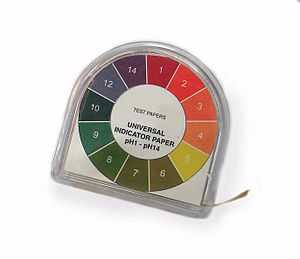Universal indicator

A Universal indicator is a pH indicator composed of a solution of several compounds that exhibits several smooth colour changes over a pH value range from 1-14 to indicate the acidity or alkalinity of solutions. Although there are several commercially available universal pH indicators, most are a variation of a formula patented by Yamada in 1933.[1] Details of this patent can be found in Chemical Abstracts.[2] Experiments with Yamada's Universal Indicator are also described in the Journal of Chemical Education.[3]
A universal indicator is typically composed of water, propan-1-ol, phenolphthalein sodium salt, sodium hydroxide, methyl red, bromothymol blue monosodium salt, and thymol blue monosodium salt.[4] The colours that indicate the pH of a solution, after adding a universal indicator are:
| pH range | Description | Colour |
|---|---|---|
| < 3 | Strong Acid | Red |
| 3-6 | Weak Acid | Orange/Yellow |
| 7 | Neutral | Green |
| 8-11 | Weak Base | Blue |
| > 11 | Strong Base | Violet/Purple |
Wide range pH test papers with distinct colours for each pH from 1 to 14 are also available. Colour matching charts are supplied with the specific test strips purchased.
See also
- Litmus test
- pH Indicator
References
- ↑ Jap. Pat. 99,664, Feb 21, 1933
- ↑ Chem Abstr, 28, 2258 (1934)
- ↑ For a discussion of these experiments, as well as recipes for Yamada and other universal indicators, see Foster, S.L. and Gruntfest, J.Chem.Educ., 14, 274 (1937)
- ↑ "Universal Indicator". ISCID Encyclopedia of Science and Philosophy.